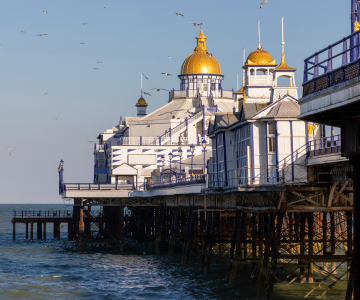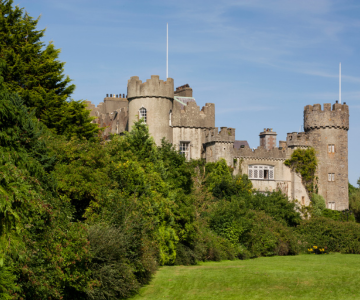
Why Eastbourne is the Perfect Place to Learn English
What do you think of when you imagine the UK?
Evie Lucas
Great British cuisine often gets a bad rep for being – well, not that Great. But beans-on-toast and jellied eels don’t tell the whole story.
When you think of British food, what comes to mind? Many people imagine something bland, uninspired – or even worse, set in aspic jelly. But it hasn’t always been this way.
In the Medieval period, the Brits were known for their roast meats, breads, pies, and stews. In fact, the French even gave them the nickname ‘Le Roast Beef’.
Everything changed during the Second World War. With rationing in full force and the arrival of American soldiers, rumours started to circulate that British food wasn’t very good. And we can’t blame them: rationing era recipes ranged from the slightly disappointing whipped margarine (instead of whipped cream) to more unhinged creations like bean and egg pies. Not to mention the occasional adventure into horse and whale meat.
While Brits no longer survive on a diet of margarine and beans, the old reputation endures. But today, British cuisine has much more to offer than you might think. From rich Beef Wellington to soft scones with cream and jam, plus a whole world of exciting international fusion dishes, there’s plenty to enjoy.
Here are 10 UK dishes that might change your mind about British food!

British puddings – and no, we don’t just mean desserts - are something else. Simple but delicious, Brits know how to make a good pudding. Think chocolate sponge with hot chocolate sauce, Eton Mess with berries and cream, apple crumble covered in smooth vanilla custard. These are the ultimate comfort foods.
The most legendary is the sticky toffee pudding, a gooey combination of buttery brown sugar sponge, chopped dates, nuts, and a generous layer of toffee sauce - best served with a scoop of ice cream.
Where to try: Most UK supermarkets will sell their own version of this famous pudding, but it’s best enjoyed after a hearty pub lunch. In London, we recommend The Abingdon, a cosy gastropub in Kensington – with comfy sofas and lots of old-school charm.
In Eastbourne, try FridayStFarm for apple pie, Bakewell tart, and roulade – all served with classic Devon custard.
Some people mistake this for Welsh Rabbit – but don’t worry, no fluffy friends are used in this dish. Instead, Welsh Rarebit is what happens when a fondue meets a grilled cheese sandwich: gooier and richer with the same satisfying crunch, it’s the best of both worlds.
To make Welsh Rarebit, you melt grated cheddar cheese into beer or ale, then pour the mix over toasted bread. It’s often topped with mustard and Worcestershire sauce for extra kick – and who said Brits can’t do flavour?
Where to try: Treat yourself to lunch at St John next to Smithfield Market in Islington, London. Considered one of the best restaurants in the world, it also happens to be known for its Welsh rarebit.
In Eastbourne, head to The Sussex Ox after a windswept day in the South Downs National Park. It’s one of the top 50 Gastropubs in the UK and has an extensive menu of British classics.

Tangy cheddar, smoky Applewood, creamy Stilton: there’s more to cheese than French Brie and Camembert. In fact, Britain has a long tradition of cheesemaking unique to the country. British cheeses are often more crumbly with a bolder flavour than many European cheeses.
While most people these days buy their cheese from the supermarket delicatessen, there are still many traditional cheesemongers across the country offering special, local varieties.
Where to try: Greenwich’s own The Cheeseboard is run by former MasterChef contestant and ‘Grand Fromage’, Michael Jones. Here you’ll find everything from Appleby’s Red Cheshire to Stinking Bishop (trust us, it tastes better than it sounds). Alternatively, The Cheese Bar in Camden offers a full menu of delicious dishes featuring ‘real British cheese’.
In Eastbourne, Hudsons Fine Foods stocks a selection of British and European cheeses alongside local pastries and classic British cakes.
One thing’s for sure: British people love pies. From sweet apple pie to meaty classics served with buttery mash and gravy, pies have been a longtime staple of the British diet.
There are too many to list, but here are a few favourites:
Steak & Ale Pie
Rich beef, slow-cooked with onions and ale, covered in golden pastry. Comfort at its best.
Cornish Pasty
Ok, not technically a pie – but close enough! These lunch-sized pastry pockets originate from Cornwall, and are usually filled with beef, potato, and swede.
Mince Pie
Don’t worry – there’s no actual meat in these Christmas treats. Mince pies are filled with ‘mincemeat’, a luxurious mixture of dried fruit, nuts, spices, brandy, and suet (a type of fat).
Sausage Rolls
Ah, the beloved sausage roll. Grab one from Greggs for just £1.30 or treat yourself to a fancy bakery version.
Pork Pies
Pork Pies are usually eaten cold. They have a rich, savoury pork filling surrounded by a thin layer of pork stock jelly. But the secret to this pie is in the hot water crust pastry: thick, crisp, and full of flavour.
Where to try: Gregg’s is a UK chain favourite for cheap, no fuss pies and pastries, but we recommend finding your nearest pub with a lunch menu for a proper pie experience. Or create your own picnic with Marks and Spencer’s selection of flavoured mini pork pies.

It might sound like a pie, but Beef Wellington deserves its own spot on the list. Named after the first Duke of Wellington, this dish is made with a whole piece of beef fillet, covered in mushrooms and shallots – sometimes pâté too – then wrapped in buttery puff pastry. Taking up lots of time, skill, and money to make, this dish is both luxurious and comforting. It’s often served with roast vegetables and a rich red wine sauce.
Where to try: Beef Wellington is notoriously expensive (often over £90), but The Grenadier in London’s Belgravia offers single portions for £39.95, including sides.
There’s a reason it’s the Great British Bake Off – Brits know how to avoid a soggy bottom. The queen of British cakes is the Victoria Sponge: light sponge with layers of jam and cream, named after Queen Victoria herself. Then there’s the Battenberg, a soft almond cake in a pink and yellow checkerboard pattern, wrapped in sweet marzipan – a grandma favourite.
Let’s not forget the breads. The delightfully named Crumpets have been saving breakfasts since the 17th century. They’re hard to describe - kind of spongey, a little chewy - but the best part is the holes on top that soak up butter perfectly. Then there are English muffins – which aren’t really muffins at all, but small, round breads cooked on a griddle. They’re crispy on the outside, chewy in the inside, and often used for Eggs Benedict or bacon and egg sandwiches.
Where to try: You’ll find most of these in any supermarket bakery aisle. But for something special, visit St John bakery in London for a mix of traditional bakes and modern treats.
Head to the award-winning Poppyseed Bakery in Eastbourne for freshly baked loaves and pastries alongside a selection of sandwiches.

What better way to enjoy British cake than with afternoon tea? If you’ve never heard of this quintessentially British tradition, it’s simple: a pot of black tea served with a three-tiered stand of tiny sandwiches, scones, and miniature cakes and pastries.
This elegant ritual has a surprisingly short history. In the mid-1800s, the Duchess of Bedford found herself getting hungry between lunch and dinner. And the solution? A tray of tea, bread, butter, and cake around 4pm. Soon, friends joined in on and it slowly became a popular social event for the upper classes.
Where to try: Afternoon Tea options in London are endless. Claridge’s and The Ritz are classic choices – but at £79 + per person, they’re also very expensive. Luckily, there are other options. The Ivy charges a reasonable £35 per person. Or try a mini version at Marks & Spencer’s for only £10 per person.
In Eastbourne, the Grand Eastbourne Hotel offers afternoon tea from £36 per person in their historic Great Hall.
This one’s for our Eastbourne students. There’s nothing like fresh haddock deep-fried in beer batter, smothered in vinegar, and finished with a sprinkling of salt. Fish and chips have been around for a long time as a quick, cheap, and hearty meal for the working classes. Not a fan of fish? There are plenty of other options: battered sausages, saveloys, pies, and chicken are almost always on the menu too. If all else fails, just go for a classic cone of chips – with the scraps (the crispy bits of batter on top), of course.
Where to try: Winning countless awards, Poppies is an East End fish and chip shop with a beautifully retro shop front and even live music. It’s also a great excuse to explore the rest of Camden.
Pedro’s is known as the best fish and chip bar in Eastbourne, but a takeout enjoyed by the coast is never a bad idea.

A true British classic – herby pork sausages and creamy mash potatoes are a match made in heaven. But why bangers? Once again, we’re travelling back to WW2. During rationing, meat was scarce, so sausages were often bulked out with more water content than they are today. The extra moisture sometimes caused them to explore when cooked – hence bangers.
Sausages are another great British staple – whether with mash, in a sausage sarnie, barbecued in July or in a full English breakfast. And there are many, many varieties to choose from. The classic Cumberland comes in a chunky spiral and is dotted with black pepper, the Lincolnshire sausage is meatier with added sage and thyme, while the West Country favours the sweet and salty combo of pork and apple.
Where to try: For the best quality, buy from a local butcher. Or, if you don’t want to fry them yourself, head to Mother Mash in Soho for sausage and mash. From cheesy mustard potatoes with Cumberland sausages to a vegan Lincolnshire sausage with sweet potato chilli mash, the combinations are endless.
In Eastbourne, we recommend The Beach Kitchen for their breakfast and brunch. Try the breakfast burger or Full English for quality sausages sourced from Deans Butchers.
Last but definitely not least: the Sunday Roast. Think golden roast potatoes that crack when you cut into them, tender beef that falls off the bone, honey-glazed carrots and parsnips, and a generous helping of rich, meaty gravy. It’s as close as you’ll feel to a renaissance feast.
Traditionally, beef is the go-to, but nowadays chicken, pork, and lamb are just as often on the menu – as well as modern additions like the vegan nut roast. The beauty of a roast dinner is in the ritual: it’s a way for families and friends to gather, catch up, and (lovingly) argue over the last Yorkshire pudding.
Where to try: Most pubs serve roast dinner on a Sunday. Near our Greenwich centre is The Cutty Sark, serving a choice of roast beef, chicken, pork, and vegan beetroot Wellington.
Located in the centre of Eastbourne, Bibendum is a great gastropub offering your meat of choice with roast garlic potatoes, honey-roasted veg, and Yorkshire pudding.
You be the judge - try it for yourself on one of our English immersion courses in Eastbourne or London.
Maybe it’s had its rough patches, but today, British cuisine is a blend of comfort, history, and bold flavours. Whether you’re enjoying a delicate Victoria sponge with tea or indulging in rich buttery pies and gravy, we’re sure you’ll find something to retire the old stereotypes.
Go on, have a crumpet.

What do you think of when you imagine the UK?

We’re back with another classic summer day trip from Dublin!

What’s the craic?
We use technology on our website to personalize content, customize and measure advertising, and analyze website traffic. By clicking OK, you agree to the use of these technologies in their entirety.
Learn more in our Privacy Policy.